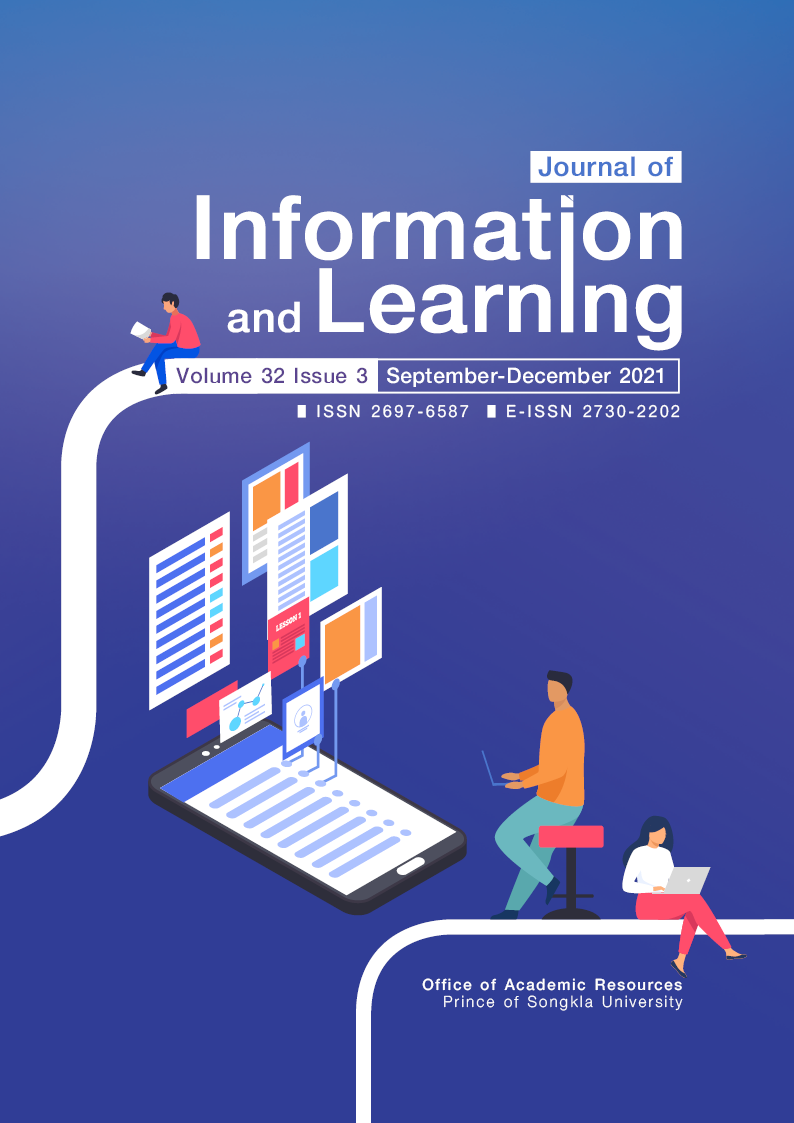The Development of Augmented Reality in Chemistry Laboratory Course to enhance Undergraduate Students’ Learning Achievement
Main Article Content
Abstract
This study aimed 1) to develop augmented reality in chemistry laboratory course with the efficiency of 80/80 and 2) to compare achievement score with pre-test score of students who studied via augmented reality in chemistry laboratory course. Participants were selected by purposive sampling. They were 137 first year engineering students from the Faculty of Engineering at King Mongkut's University of Technology Thonburi in Ratchaburi. The research tools comprised 1) the augmented reality in chemistry laboratory course, 2) achievement tests, and 3) a questionnaire to evaluate students’ satisfaction. Data were analyzed by using average percentage standard deviation statistics and t–test dependent. The research revealed that the efficiency of the augmented reality in the chemistry laboratory course was 88.46/80.33. The students’ learning achievement after learning via augmented reality was higher at the .01 level of significance. The satisfaction of students towards augmented reality in the chemistry laboratory course was at a high level.
Article Details

This work is licensed under a Creative Commons Attribution-NonCommercial-NoDerivatives 4.0 International License.
The Journal of Information and Learning is operated by the Office of Academic Resources, Prince of Songkla University. All articles published in the journal are protected by Thailand copyright law. This copyright covers the exclusive rights to share, reproduce and distribute the article, including in electronic forms, reprints, translations, photographic reproductions, or similar. Authors own copyrights in the works they have created as well as the Office of Academic Resources. The Journal reserves the right to edit the language of papers accepted for publication for clarity and correctness, as well as to make formal changes to ensure compliance with the journal's guidelines. All authors must take public responsibility for the content of their paper.
References
Akçayır, M., Akçayır, G., Pektaş, H.M., Ocak, M.A., (2016). Augmented reality in science laboratories: The effects of augmented reality on university students’ laboratory skills and attitudes toward science laboratories. Computers in Human Behavior, 57, 334-342.
Bareau of Academic Affairs and Education Standards Office of the Basic Education Commission, Ministry of Education. (2018) Indicators and Learning Areas in Science of Basic Education Core Curriculum. Bangkok: The agricultural co-operative federation of Thailand.
Brahmawong, C. (2013). Media or instructional package efficiency testing. Silpakorn Educational Research Journal, 5(1), 7-20.
Cai, S., Wang, X., & Chiang, F. K. (2014). A case study of augmented reality simulation system application in a chemistry course. Computers in Human Behavior, 37, 31-40.
Chang, H.Y., Wu, H.K., & Hsu, Y.S. (2013). Integrating a mobile augmented reality activity to on textualize student learning of a socioscientific issue. British Journal of Educational technology, 44(3), E95–E99.
Ditcharoen, N., Polyiam, K., Vangkahad, P. & Jarujamrus, P. (2014). Development of learning media in topics of atomic structure and chemical bond with augmented reality technology. Journal of Re-search Unit on Science, Technology and Environment for Learning, 5(1), 21-27.
Dornbundit, P., Tongraung, P., & Sanamontre, A. (2016). Effect of an online chemical introduction program for first-year undergraduates in the faculty of science. Journal of Research Unit on Science, Technology and Environment for Learning, 6(2), 209-216.
Jamjuree, D. (2020). Learning design for gen z. Bangkok: The Graduate School of Srinakharinwirot University.
Janjaroen, K. (2009). Nursing research: Concepts, principles and practices. Nonthaburi: Praboromarajchanok Institute.
Kularbphettong, K., Vichivanives, R., & Roonrakwit, P. (2019). Student learning achievement through augmented reality in science subjects. In Proceedings of the 2019 11th International Conference on Education Technology and Computers (ICETC 2019) (pp. 228-232). United States: Association for Computing Machinery.
McGriff, S. (2000). Instructional System Design (ISD): Using the ADDIE model. USA, Pennsylvania: Pennsylvania State University.
Palmer, D. H. (1999). Exploring the link between students' scientific and nonscientific conceptions. Science Education, 83(6), 639-653.
Phornphisutthimas, S. (2008). Teaching science underlining process skills. Advanced Science Journal, 8(2), 28-38.
Srisa-ard, B. (2003). Research for teacher. Bangkok: Suweeriyasan.
Tansiri, P. (2010). Augmented reality. Executive Journal, 30(2), 169-175.
Tatli, Z., & Ayas, A. (2013). Effect of a virtual chemistry laboratory on students’ achievement. Educational Technology & Society, 16(1), 159-170.
Techakosit, S., & Nilsook, P. (2016). The learning process of scientific imagineering through AR in order to enhance STEM literacy. International Journal of Emerging Technologies in Learning, 11(7), 56-63.
Thummathong, R., & Thathong, K. (2018). Chemical literacy levels of engineering students in Northeastern Thailand. Kasetsart Journal of Social Sciences, 39(3), 478-487.
Tüysüz, C. (2010). The effect of the virtual laboratory on students’ achievement and attitude in chemistry. International Online Journal of Educational Science, 2(1), 37-53.
Ulao, K., Sirionnrang, P., & Bojukrapan, S. (2016). The development of the instructional media with augmented reality technology entitled atomic model for matthayomsuksa 4 students. Journal of Project in Computer Science and Information Technology, 2(2), 73-80.
Waenasae, R., Napapongs, W., Kaosaiyaporn, O., & Tehhae, I. (2020). Effects of using augmented reality for improving learning achievement on arabic consonant pronunciation of grade 3 students. Journal of Information and Learning, 31(3), 11-24.
Wongyai, N. (2017). A guide to developing digital literacy skills of digital native. Veridian E-Journal, Silpakorn University, 10(2), 1630-1642.


